
 |
|
#121
|
||||
|
||||
|
Quote:
BTW - redwood is difficult because it likes to split. If you decide to build another one, I have a few tops that you might like to look at and perhaps take home - cedar, lutz, adirondack, redwood, sinker redwood, figured redwood.
__________________
“Reason is itself a matter of faith. It is an act of faith to assert that our thoughts have any relation to reality at all.” ― G.K. Chesterton |
|
#122
|
|||
|
|||
|
Quote:
As to cedar I wouldn't shy away from it. Yes it does require greater care in handling but I really like the look and sound of cedar, especially for fingerstyle. One thing, however, that you found out, is that you have to be very clean when working cedar. The other thing is that when you get a set, you should de a deflection test BEFORE you join and defintely BEFORE you sand. Using the "cube rule of stiffness" it doesn't take a lot to drastically decrease stiffness. So I would do everything possible to protect the top (kraft paper) so you don't thin it further. |
|
#123
|
|||
|
|||
|
Good work. The rosette came out nice. I love working with scrapers and hand tools as well, but learning to use them on a soft wood like cedar made it doubly hard for me.
I don't know anything about deflection testing but can attest that cedar is daunting for a first guitar build - at least it was for me. If you look at it wrong you'll leave a mark.
__________________
(2006) Larrivee OM-03R, (2009) Martin D-16GT, (1998) Fender Am Std Ash Stratocaster, (2013) McKnight McUke, (1989) Kramer Striker ST600, a couple of DIY builds (2013, 2023) |
|
#124
|
|||
|
|||
|
Quote:
Be that as it may, your offer is far too generous, unless you simply meant that they are for sale, in which case it is certainly a possibility.  And please forgive me if I don't sound excited to meet you in person. I have a number of autistic tendencies and personality traits... I'm not much of a people person. Quote:
Quote:
__________________
-- Nick |
|
#125
|
|||
|
|||
|
Got some more good work done today. Cut the sound hole and the rough profile of the guitar top. Then I re-sawed my white oak for the sides.
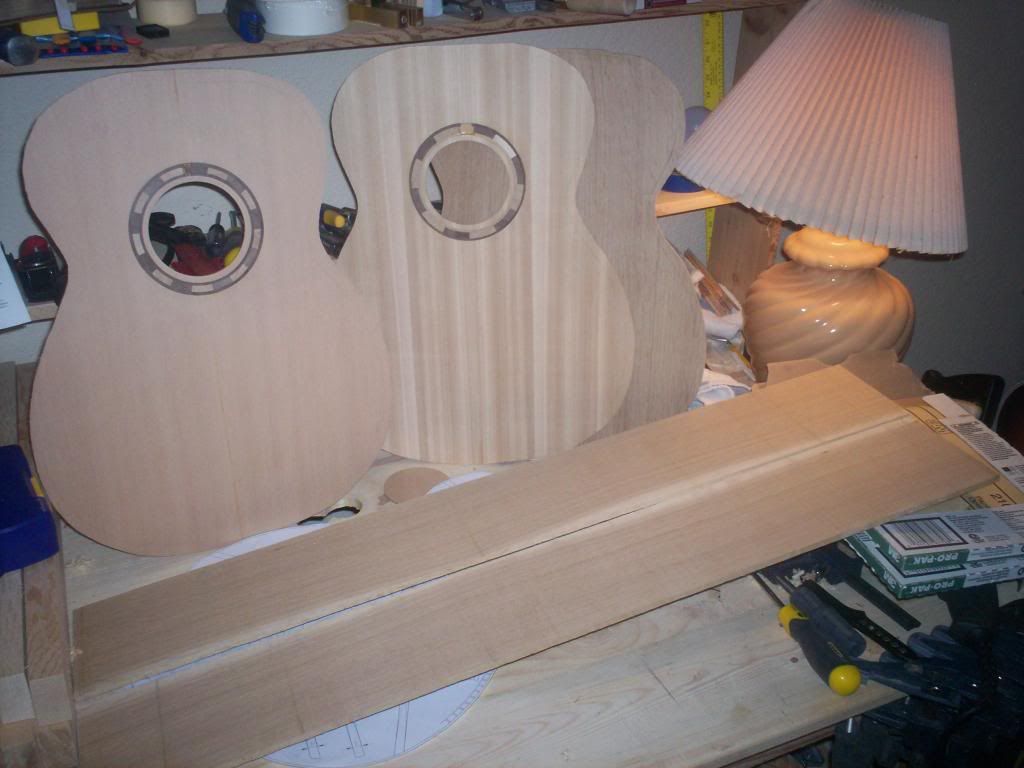 My band-saw re-sawing setup. 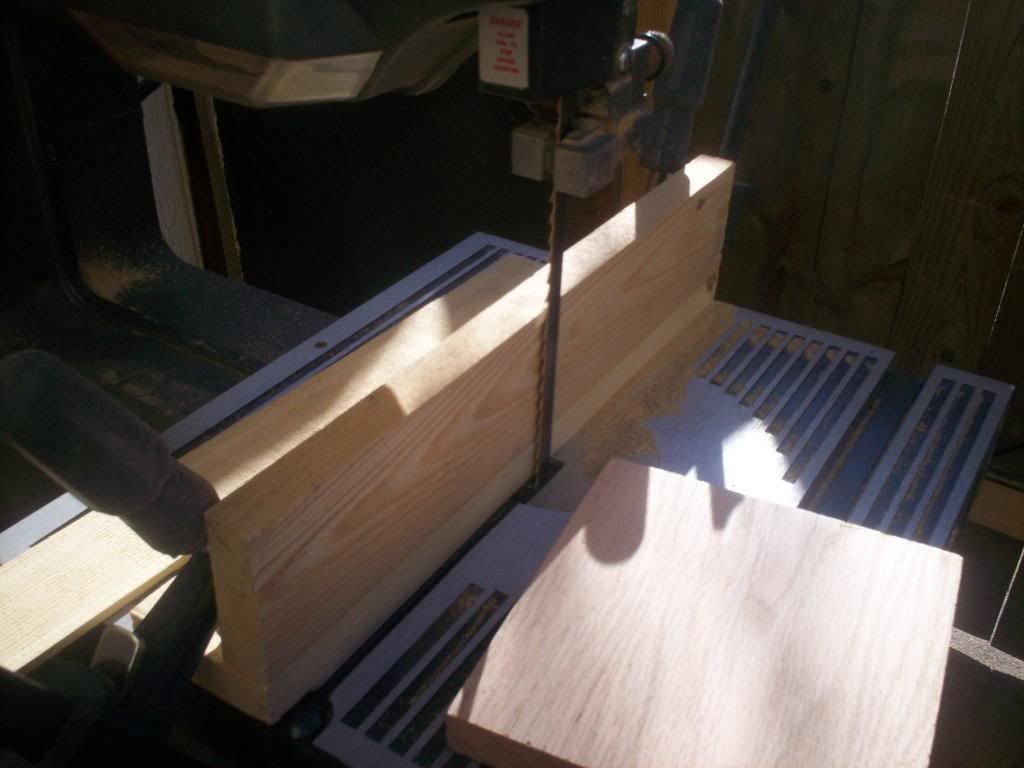 The sides, freshly re-sawn. They are 1/4" thick. I'll use my drum sander to thickness them down to size. What size do you thickness them down to? I've read .09-.08 inches.  Not certain if I want to include the sapwood on the sides or not. Perhaps it would be better to just include it on the back but not the sides. What do you guys think? Next, I'll be spending time on more infrastructure. I need to make some cam-clamps for gluing bracing to the top and back. Then I also need to put together the side bending machine. I'll be going the light bulb rout.
__________________
-- Nick |
|
#126
|
|||
|
|||
|
Quote:
Also, if you want to get some decent top woods, check out your local lumberyard. If they'll let you sort through stock (and of course put it back neatly) you can find some nice quartered 2X12 clear WRC, even Sitka if you have a decent lumberyard. Last I went I paid $15/lf for 2x12 clear WRC (my lumberyard does not stock 2x10 or 2x8 in clear.) I think if you're careful about protecting the top and resist sanding until the very end and only then lightly you should be fine. |
|
#127
|
|||
|
|||
|
I totally can't wait for that moment. Thus far, it seems that everything I've done has been very 2 dimensional. Once the braces get added, it almost feels like something magical will take place. Can't wait. Plus, yeah, not much in terms of tap tone to the cedar right now. 1 clear note prior to cutting the guitar's shape out. Not much of anything right now. I'd really like to begin to hear the music in the wood. I've read that once the braces are added to the equation, it changes everything.
__________________
-- Nick |
|
#128
|
|||
|
|||
|
Quote:
As to side thicknessing, I'm not sure for oak. I've bent padauk sides at .110" and had NO problems despite reports that it's hard to bend and split-prone. Then I've bent walnut sides aroun .080" and had a hard time. I bend old-fashioned with a propane-torch heat pipe. I've changed my approach over the years, and I've been sizing my side woods to .040"-.050" and laminating the sides. This seems to work great wiith flatsawn sides (like quilt maple) where I use quartered wood for the inner pieces, and really keeps them flat and they hold shape even when I take the sides off my mold. I still make my tops on a dead flat work surface; and use a shop-made 15.5' radus dish for the backs (partly because everyone seems to use 15') which is integral to my mini-gobar deck. |
|
#129
|
|||
|
|||
|
So I started in on making cam clamps. Since I've never made one before, I decided to make just 1 and see if I could produce some decent results. I'm not quite done with it, but I like the results so far. I feel fairly certain it will do it's job. I do however finally need a drill press to drill the cam fulcrum and the relief hole for the upper jaw cut. I knew it was inevitable. I'll have to get the drill press before I can complete the cam clamps, so I'll be waiting a while to get back to the guitar.
 These are made from a really great piece of white oak I found at the local specialty hardwood supplier's cast off bin. 6 feet long, 1.5 inches thick and 5.5 inches wide for 5 bucks. It had some checking on the end which is why it ended up in the bin. But I'll work good for this purpose. 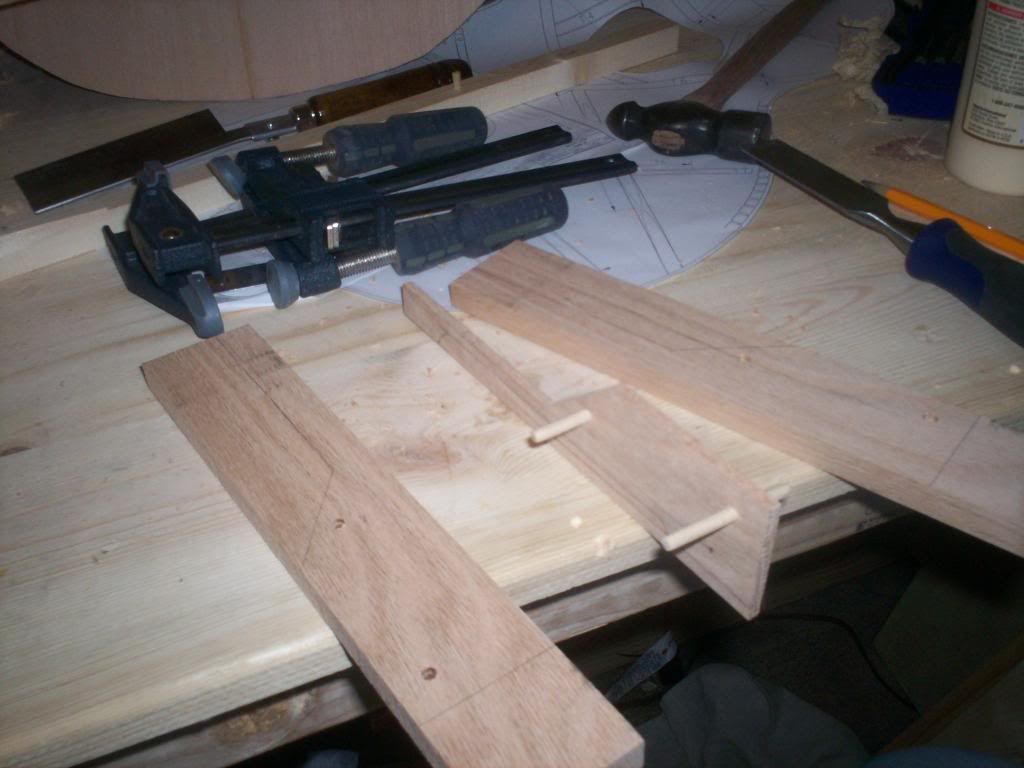 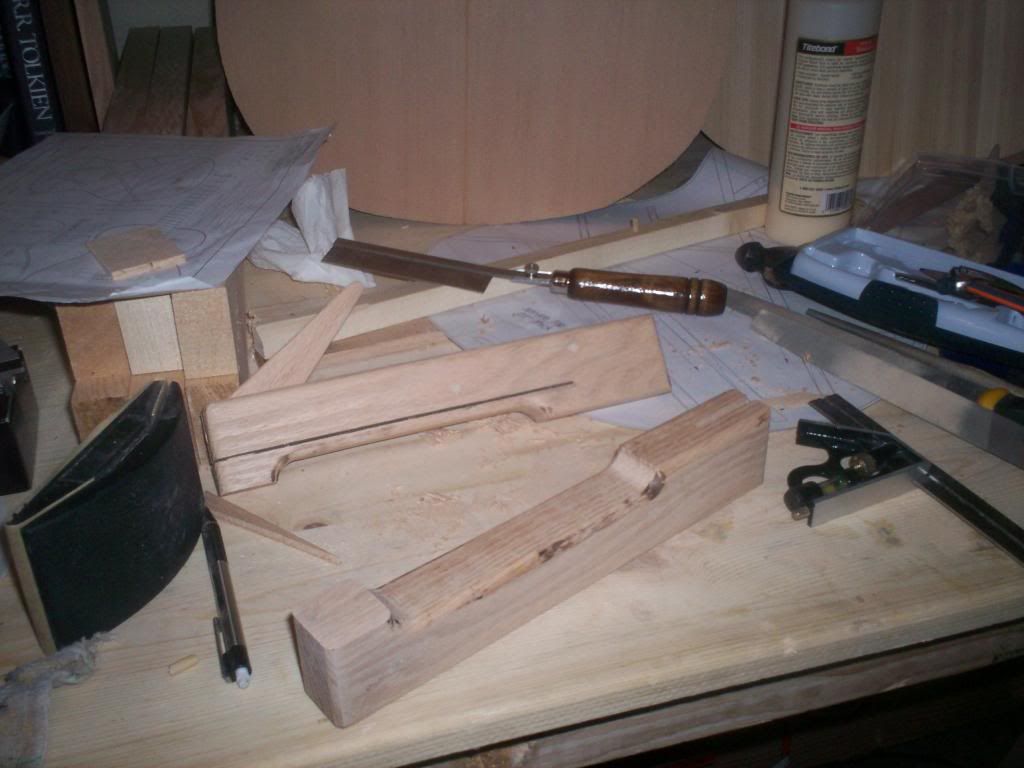 These will have 8.5 inch jaws. Sufficient to reach the middle of the x for the x brace. 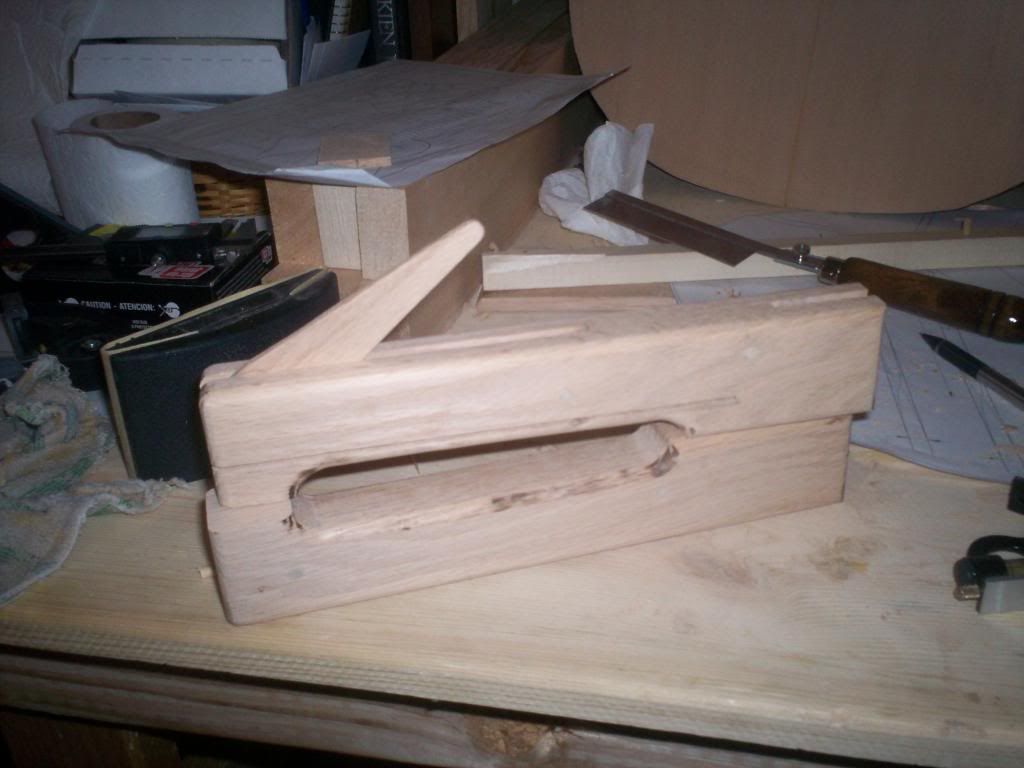 And, joy of joys, my band saw blade is finally getting dull. I've resawed a bunch of cedar with it, a bunch of white oak, cut a bunch of maple on it when I made my plane. So I suppose this has been a good stretch. Why can't tools just stay sharp indefinitely? 
__________________
-- Nick |
|
#130
|
|||
|
|||
|
...because you're working with oak!
 Seriously, I tried making cam clamps too and I guess I didn't try hard enough because they came out terrible. I too used oak and the blade on my little Ryobi bandsaw was SMOKIN! Probably the biggest drawback was that I didn't use steel bars so the jaws kept slipping on the oak bar I opted to use instead. Fortunately for me, I have a friend nearby who has a couple dozen Stewmac cam clamps and the local Rockler had them on sale too. I bought a pair with 4-1/2" throats for about HALF the price of ONE comparable Stewmac cam clamp.
__________________
(2006) Larrivee OM-03R, (2009) Martin D-16GT, (1998) Fender Am Std Ash Stratocaster, (2013) McKnight McUke, (1989) Kramer Striker ST600, a couple of DIY builds (2013, 2023) |
|
#131
|
|||
|
|||
|
LOL. You and your obsession with the hardness of oak.
 Quote:
__________________
-- Nick |
|
#132
|
|||
|
|||
|
A go bar deck is both easier to use for gluing braces and easier to build also. you could make the rods from left over oak. Using different lengths of rods you could also use it for gluing the top and back to the sides.
Last edited by gpj1136; 02-24-2014 at 02:46 AM. |
|
#133
|
|||
|
|||
|
Quote:
|
|
#134
|
|||
|
|||
|
Quote:
__________________
(2006) Larrivee OM-03R, (2009) Martin D-16GT, (1998) Fender Am Std Ash Stratocaster, (2013) McKnight McUke, (1989) Kramer Striker ST600, a couple of DIY builds (2013, 2023) |
|
#135
|
|||
|
|||
|
Quote:
 Quote:
Quote:
I'll have to plunk down a few bucks and get a decent microphone so I can record something. I tend to think the species of wood doesn't have much to do with the sound. Perhaps it does in an 80/20 rule kind of way. 80% of the sound will be directly attributed to the builder... the construction, the bracing, the thickness, stiffness and mass of the top, the care taken in striking the right balance for the target guitar and how it was built, etc.. Then the final 20 might represent the coloring of the sound due to the species. I once played an all solid wood spruce and rosewood instrument in a nice, locally owned (non GC) guitar store. I took one look at it and smiled, thinking that it's a classic combination and that the guitar should sound great. Sat down with it and started playing a finger style melody. It was mediocre in every regard. I didn't play it long and stuck it back on the wall a little disgusted. I'm sure the species of wood makes a difference once you are building at an elite level, once you can already make excellent, lightly built, highly responsive guitars regardless of the wood. THEN the species can begin to make a subtle difference because the builder has fine tuned his construction methods enough to actually release the character a particular species has to offer. But, that's just my opinion based on a small amount of playing talent and the guitars I've played. Obviously not based on observations from having built lots of guitars. So I hope my guitar sounds nice, though I would not say it would be representative of the sound one could expect from a well built oak b/s instrument.
__________________
-- Nick |